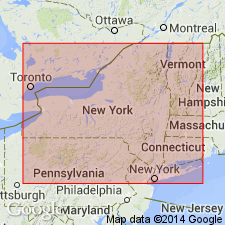
- Usage in publication:
-
- Adirondack anorthosyte
- Modifications:
-
- Original reference
- Dominant lithology:
-
- Anorthosite
- AAPG geologic province:
-
- Adirondack uplift
Summary:
Pg. 82. Adirondack anorthosyte. It is pretty generally agreed that during the middle Precambrian, three igneous masses invaded the Adirondack area. These were (1) the anorthosyte, (2) the "syenyte" and allied "[granites]," and (3) the "basic gabbros." Local expressions of these have cognomens, but there is need for a general term for each. It is here proposed to call them respectively by names long unofficially in use by some of us, respectively: (1) the Adirondack anorthosyte; (2) the Ausable "syenyte" or nordmarkyte series (named for development along Ausable River and in quarries around Ausable Forks, New York); and (3) the Elizabethtown gabbros (named for development around Elizabethtown, New York). The names Mount Marcy, Whiteface, and Split Rock [where published?] apply only to local differentiation and assimilation phases of the anorthosyte, of which Marcy type is most widespread and typical. While the term "Adirondack gneisses" has sometimes been loosely employed without definition for the Precambrian rocks of northern New York as a whole, it lacks currency today and can have no claim against the appropriate application of Adirondack to the anorthosyte mass than constitutes all the high central peaks of true Adirondack Mountains. A cataclastic phase of this rock from south of Ausable Forks, New York, has gone on market as "Adirondack granite." Age is pre-Cambrian.
Source: US geologic names lexicon (USGS Bull. 896, p. 14-15); supplemental information from GNU records (USGS DDS-6; Reston GNULEX).
For more information, please contact Nancy Stamm, Geologic Names Committee Secretary.
Asterisk (*) indicates published by U.S. Geological Survey authors.
"No current usage" (†) implies that a name has been abandoned or has fallen into disuse. Former usage and, if known, replacement name given in parentheses ( ).
Slash (/) indicates name conflicts with nomenclatural guidelines (CSN, 1933; ACSN, 1961, 1970; NACSN, 1983, 2005, 2021). May be explained within brackets ([ ]).

